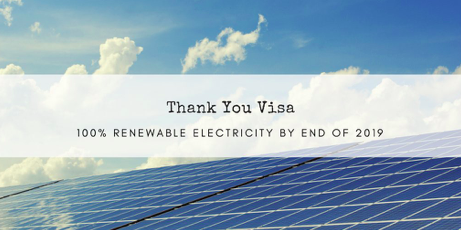Credit card giant Visa recently announced its commitment to use 100 percent renewable electricity across its global operations by the end of 2019. This is a great victory for clean energy advocates as the company is involved in countless transactions around the world every day.
Although there are a significant and growing number of financial institutions committing to 100 percent renewable energy, Visa is one of the highest profile yet—and importantly, it’s one that virtually every consumer is familiar with.
Other such ubiquitous companies committing to 100 percent renewable energy, like Microsoft, Proctor & Gamble, and Starbucks, are such a part of our daily routines that it’s fair to say renewable energy now has a broad reach into every part of the economy and can touch almost every consumer today in some way. In fact, the RE100 companies, a collaborative initiative bringing together the world’s most influential businesses committed to 100 percent renewable power, have a total revenue of over US$2.75 trillion and account for more than 160TWh of renewable electricity demand, and they are capturing the attention of many investors and policymakers, including conservatives.

Remarkably, Visa’s global electricity consumption is a 35 percent mix of renewable energy sources such as solar and wind. By consuming renewable resources, Visa is directly contributing to the stellar job creation these industries have demonstrated; according to the U.S. Department of Energy, nearly 800,000 workers were employed in low-carbon emission generation technologies through 2016, including 374,000 individuals who work, in whole or in part, for solar firms and an additional 102,000 workers employed at wind firms across the nation. Amazingly, the solar and wind industries are each creating jobs at a rate 12 times faster than that of the rest of the U.S. economy!
Turning over the remaining 65 percent in less than two years is an incredibly ambitious goal, but it is possible, and we have seen that these resources yield considerable returns on investment. Their efforts will be worth it, not only in terms of reducing global emissions, but also in terms of cost savings.
It’s increasingly clear that the private sector is leading the transition to a clean energy economy, which is what CRES is striving to make a reality. Government support and private-public partnerships are often necessary in the research and development stages and in building out infrastructure, but once clean energy technologies mature and have a level playing field, the free market will choose them in most cases because it just makes sense.
We thank Visa for their commitment to 100 percent renewable, and we want to shine the spotlight on businesses of all sizes that are setting similar goals. Stay tuned—we will be posting regularly on this topic, starting soon with our next post profiling Apple.
